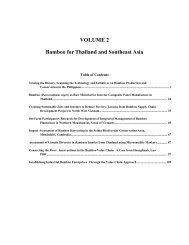WBC-VIII-Vol.4 – Resources – Forestry, Plantations and ... - BambuSC
WBC-VIII-Vol.4 – Resources – Forestry, Plantations and ... - BambuSC
WBC-VIII-Vol.4 – Resources – Forestry, Plantations and ... - BambuSC
You also want an ePaper? Increase the reach of your titles
YUMPU automatically turns print PDFs into web optimized ePapers that Google loves.
Dynamics of P. bambuoides Forest during the Recent 16 years<br />
Trees<br />
Table 3 shows the change of main tree species number during recent 16 years in the research site. In 1992, 262<br />
trees of 21 species (deciduous: 13, evergreen: 8) existed in 40m*40m quadrate, <strong>and</strong> 25 trees (9.5%) formed<br />
forest canopy with bamboo. Main tree species forming forest canopy was Aphananthe aspera, Celtis sinensis<br />
<strong>and</strong> Zelkova serrata etc.. The rest 237 trees, mainly evergreen broad-leaved species, were not the component of<br />
forest canopy, <strong>and</strong> existed as the component of forest floor vegetation.<br />
In 1999, tree species number decreased to 177 of 12 species (deciduous: 6, evergreen: 6). However, the number<br />
of trees forming forest canopy was invariable (25 individuals) <strong>and</strong> the rate of them increased to 14%. The<br />
individuals of Aphananthe aspera, Zelkova serrata <strong>and</strong> Ligustrum japonicum did not decrease. The former two<br />
species are forming forest canopy, <strong>and</strong> the latter is the component of shrub layer. Quercus glauca showed<br />
comparatively dynamic change. In many cases, although its trunks which were alive in 1992 died during the<br />
following years, it produced coppice shoots again. This kind of ability to produce new shoots is superior on this<br />
species. But other species poor in this ability tend to decrease their individuals. All Cryptomeria japonica,<br />
planted species, died out during the research. The seedlings <strong>and</strong> saplings of tree species composing the forest<br />
canopy were seldom shown in the forest floor layer except a little amount of Zelkova serrata saplings.<br />
In 2003, although the number of trees decreased a little to 165, tree species components <strong>and</strong> forest canopy<br />
forming trees did not change. Decrease of the number caused by the slow-down of decrease of Camellia<br />
japonica, Neolitsea sericea <strong>and</strong> Cinnamomum sieboldii after 1999. On the other h<strong>and</strong>, the decrease of Celtis<br />
sinensis was continuing. It is considered that the change of tree species tends to become stable.<br />
Phyllostachys bambusoides<br />
The density of new culms of P. bambusoides changes every year. In the research site, the number per hectare<br />
was 738, 788, 550 <strong>and</strong> 538 in 1995, 1998, 2000 <strong>and</strong> 2006 respectively, <strong>and</strong> in the other years it was from 200 to<br />
390. This gives us a presumption that every two or three years this site produces a large number of new culms<br />
except the case of 2003 (Table 4). The distribution of new culms diameter (Figure 1) shows a lot of thin culms<br />
probably because of unmanaged condition. All of these culms are short <strong>and</strong> impossible to form forest canopy.<br />
The average of diameters was smaller on every following year of the year when bamboo forest produced large<br />
number of new culms.<br />
The age structures of every diameter of surviving culms in the spring of 2003 <strong>and</strong> 2007 are shown on Figure 2<br />
<strong>and</strong> Figure 3, respectively. The average diameters of all culms in each year were 6.39 cm <strong>and</strong> 6.34 cm<br />
respectively. The diameter of a large quantity of culms is from 6 to 8 cm, <strong>and</strong> there are a lot of culms more than<br />
11 years old. The diameter of main culms forming the forest canopy was more than 6 cm. On the other h<strong>and</strong>,<br />
thinner the culm was, shorter its longevity was. The culms with comparatively long longevity were more than 3<br />
cm culms in diameter, <strong>and</strong> the culms of diameter less than 2 cm had extremely short longevity. This is also<br />
understood by the smaller average diameter of new culms on every year than those of surviving culms in 2003<br />
<strong>and</strong> 2007.<br />
<strong>VIII</strong> World Bamboo Congress Proceedings Vol 4-141




